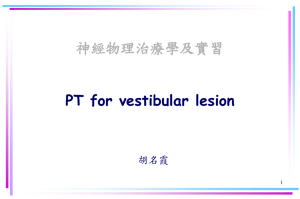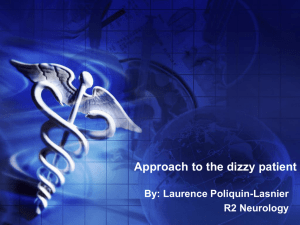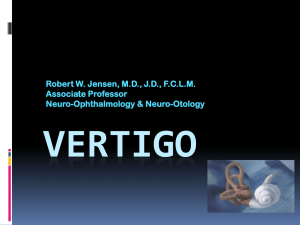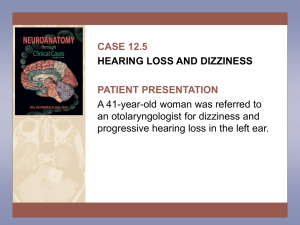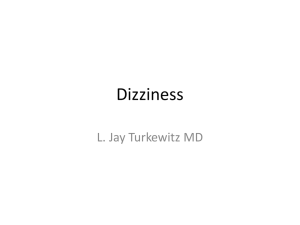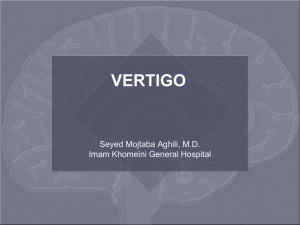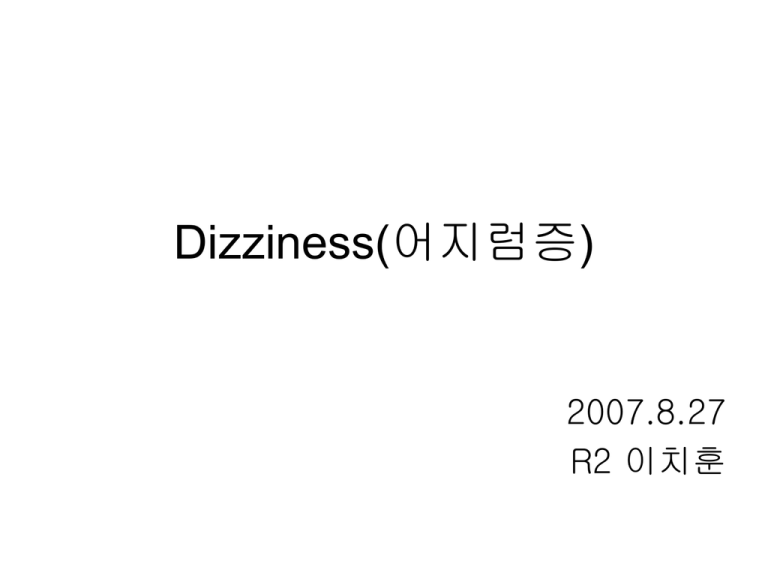
Dizziness(어지럼증)
2007.8.27
R2 이치훈
어지럽다 ?
•
•
•
•
•
•
•
•
•
•
•
•
•
•
•
•
•
•
주위가 빙빙 돈다
머리 속이 도는 것 같다
빈혈이 있다
속이 니글거린다. 토할 것 같다. 체한 것 같다
머리가 띵하다. 머리가 멍하다. 머리가 무겁다.
머리가 텅 빈 느낌이다
목이 뻣뻣하고 머리가 맑지 않다
정신은 멀쩡한데 술에 취한 것 같이 비틀거리며 걷는다
보이는 것이 흔들린다
아찔하다. 눈 앞이 캄캄해진다. 기운이 없고 쓰러질 것 같다.
걸을 때 땅이 울렁거린다
지하철이나 버스가 지나가면 쏠려 들어갈 것 같다
움직이는 물체를 볼 때 어지럽다
넓은 곳에 가면 어지럽다
구토를 하고 눈을 뜰 수가 없다
붕 떠 있는 듯하고 잘 걸을 수 없다
땅 속으로 꺼지는 느낌이다
달리 표현할 방법이 없이 그냥 어지럽다
INTRODUCTION
•
•
•
"Dizziness" : nonspecific term - sensation of
altered orientation in space(공간에 대한 지남력의 변
화로 인한 이상 감각)
most common disorder :
1. vertigo
2. nonspecific dizziness
3. disequilibrium
4. presyncope
Dizziness 환자 평가시 첫번째로 해야할 가장 중요한
step은 상기 specific category를 정하는 것!!!
• 여러 dizziness 원인의 분포 정도가 primary care setting,
emergency department, specialized dizzy clinic에서
매우 유사함
– 40 percent of dizzy patients : peripheral vestibular
dysfunction
– 10 percent : central brainstem vestibular lesion
– 15 percent : psychiatric disorder
– 25 percent : presyncope and disequilibrium
– 10 percent : uncertain
• 어지러움에 대한 기술(description)이 dizziness etiology
를 밝히는데 중요!!
• History가 가장 sensitive : identifying vertigo (87
percent), presyncope (74 percent), psychiatric
disorders (55 percent), and disequilibrium (33
percent)
VERTIGO
• illusion of motion ; self-motion or motion of the
environment
• most common perception - "spinning (whirling,
rotation)" sensation
• 간혹 linear displacement, tilt sense로 인해 "moving",
"tilting" 과 같이 표현하기도
• vestibular system의 imbalance(asymmetry)에 의해 발생
• vestibular system
– vestibular apparatus in the inner ear
– vestibular nerve and nucleus within the medulla
– connections to and from the vestibular portions of the
cerebellum
Crista ampullaris (3 SCCs)
Macula (Utricle, Saccule)
Cupula (SG=1)
Mucopolysaccarides
Otoconia, otolith
Calcium carbonate (SG=2.7)
Head rotation
(Angular acceleration)
Head position (Gravity)
Head translation (Linear acceleration)
Saccule
Utricle
Semicircular canal
Distinguishing vertigo from other
types of dizziness
• The spinning quality of vertiginous sensations
is notoriously unreliable!!!
– Spinning sense가 아니라고 해서 vestibular disease
를 배제하지 못함
– Presyncope인데 woozy, faint feeling을 spinning
sensation으로 이해하고 표현하는 경우
• Dizziness의 time course, provoking factor,
aggravating factor가 dizziness의 원인을 밝히는
데 더 유용함!!!
Time course
• vestibular lesion이 영구적인 것일지라도 CNS가 그 defect에
적응하기 때문에 vertigo는 수주에 걸쳐 subside
• 수개월간 꾸준히 지속되는 dizziness는 보통 psychogenic,
not vestibular
Provoking factors
• 어떤 종류의 vertigo는 저절로 발생하는 반면, head
position 이나 middle ear pressure (eg, coughing,
sneezing, or Valsalva maneuvers)를 바꾸는 maneuver
에 의해서 유발되는 것도 있음
• Positional vertigo와 postural presyncope
– 종종 혼동되는 두 가지 흔한 condition
– 둘다 잠자리에서 일어날 때와 같이 standing시의 dizziness와 관
련
• 둘을 구분하는 key : BP를 떨어뜨리거나 뇌혈류의 감소
없이 head position을 바꾸는 maneuver를 통해서
dizziness 발생 여부를 확인
– lying down, rolling over in bed, bending the neck back to look
up
– 위와 같은 상황에서 dizziness 발생하면 positional vertigo, not
postural presyncope.
Aggravating factors
• vertigo는 head motion시 더 심해짐!!!
; Vertigo를 다른 종류의 dizziness와 구분하는
데 매우 유용
• vertiginous attack 중에는 움직임을 멈추
게됨
• head motion이 어지러운 느낌을 더 악화
시키지 않는다면 vertigo가 아닌 다른 type
의 dizziness일 가능성 큼
Associated signs and symptoms
• Vertigo(central or peripheral origin)는 일반적
으로 nystagmus와 postural instability를 동반
• Ear symptom(hearing loss, tinnitus, ear
fullness) 이나 brainstem sign(dysphagia,
dysarthria, diplopia, ataxia, motor weakness,
sensory change, incoordination) 등도
peripheral과 central cause of vertigo 구분에
도움
Nystagmus
•
•
•
•
불수의적 안구의 진동현상(oscillation)의 하나
느린 운동으로 진동이 시작되는 경우
보통 빠른 안구운동과 느린 안구운동이 교대로 나타남
안진의 방향은 빠른 안구운동 쪽으로 함
Vestibular imbalance
-> Abnormal deviation of eye (slow)
-> Compensatory eye movement (fast)
Nystagmography
• Nystagmus ->호소하는 dizziness가 vertigo !!!
• physiologic nystagmus - lateral gaze시에 보
이는 bilaterally symmetric appearance of a
few beats of horizontal nystagmus
• Pathologic nystagmus - asymmetric or more
pronounced or prolonged
• Nystagmus 특징을 통해 central과 peripheral
vertigo를 구분!!!(표)
Functions of the extraocular muscles
(yoke muscle;동향근)
Extraocular muscles activated by the
stimulation of the semicircular canals
can be inferred because muscle
planes of the extraocular muscles
excited by the canals lie in planes
similar to those of canals; an anterior
canal, when stimulated, excites the
ipsilateral superior rectus muscle and
the contralateral inferior oblique
muscle (thin dotted lines); a posterior
canal,when stimulated, excites the
ipsilateral superior oblique muscles
and the contralateral inferior rectus
muscles (solid dotted lines); a
horizontal canal excites the
ipsilateral medial rectus muscle and
the contralateral lateral rectus
muscle (thick dotted lines).
Schematic summary of semicircular canal excitation and corresponding eye
movements. Arrows indicate the direction of the slow phase of the eye
movements, not the fast phase of the induced nystagmus
CAUSES OF VERTIGO
• Vertigo의 원인
– peripheral disorder
– central disorder
• 서로 구분되는 clinical feature를 갖지만 어느 정
도는 overlap
• Peripheral cause가 80% :
– benign paroxysmal positional vertigo
– vestibular neuritis
– Meniere's disease
PERIPHERAL ETIOLOGIES
•
•
•
•
•
•
•
•
•
•
Benign paroxysmal positional vertigo
Vestibular neuritis
Herpes zoster oticus
Meniere's disease
Labyrinthine concussion
Perilymphatic fistula
Semicircular canal dehiscence syndrome
Cogan's syndrome
Recurrent vestibulopathy
Other disorders
– Acoustic neuroma
– Aminoglycoside toxicity
– Otitis media
Benign paroxysmal positional
vertigo
• 어떤 형태의 vertigo와 nystagmus는 중력에 대해 머리 위치를
바꾸었을 때만 분명하게 나타남 -> positional vertigo
• central (eg, brainstem or cerebellum)과 peripheral (eg,
canalithiasis) vestibular lesion 모두 positional nystagmus
와 vertigo를 발생
• Central positional nystagmus는 보통 static(머리가
provoking position을 유지하는 한 nystagmus는 지속)
• peripheral vestibular pathology로 인한 positional vertigo는
항상 transient
• Nystagmus direction, latency, fatiguability를 관찰하는 것이
감별에 도움
• atypical feature nystagmus나 undetermined origin
nystagmus를 보이면 neurologic investigation 필요
• BPPV - most common positional vertigo
(peripheral vestibular dysfunction 환자의 ½)
• dizziness clinic에 방문하는 환자의 18%,
vestibular testing 위해 보내진 환자의 25%
• no race, age, sex predilection
• recurrent episode의 vertigo 증상이 1분 혹은 그
이하로 지속됨
• 비록 각각의 episode는 짧지만, 대개 치료가 없
으면 수주에서 수개월마다 재발
• 특정한 head movement에 의해 유발 - looking
up while standing or sitting, lying down or
getting up from bed, and rolling over in bed
• nausea와 vomiting을 동반
• no other neurologic complaints
BPPV - Etiology and
pathogenesis
• 가장 흔한 원인 : posterior semicircular canal
안의 calcium debris (소위 canalithiasis)
; debris는 utricular sac 안에 있던 otoconia (calcium
carbonate crystals)가 떨어져 나간 것
• semicircular canal은 angular head
acceleration을 감지
• Heavy debris in the canal -> endolymph의
inappropriate movement 발생 -> head shifts
시 erroneous sensation of spinning 발생
• Classic posterior canal BPPV
– Idiopathic (35%)
– Prior minor head trauma (15%)
– 나머지는 다양한 vestibular pathology의
residual effect : Meniere's disease (30%),
vestibular neuronitis, ear surgery, inner ear
ischemia
• horizontal canal BPPV
– 대부분 idiopathic 또는 minor head trauma
– 간혹 posterior canal BPPV 치료 위한
maneuver의complication으로 발생
BPPV - Variants
• three variants : anterior canal, horizontal canal, pure
torsional
• Anterior canal BPPV
– classic posterior canal BPPV와 유사한 provoking factors
– nystagmus : downbeat and torsional
– latency, duration, fatiguability는 유사함
• Horizontal canal BPPV
– 누운 상태에서 머리를 좌우로 돌릴 때 유발, 간혹 서있는 상태에
서 머리를 돌릴 때 발생, 하지만 침대에 눕거나 일어날 때 혹은
고개를 쳐들 때 발생하지 않음
– supine position에서 lateral head turn을 할 때 nystagmus 유발
– affected ear down시에 약 1~8초 후 Horizontal
nystagmus beating toward the floor 발생. 대략 1분
간 지속
– normal ear down 시에는 milder beating toward the
ground nystagmus 관찰
– 대략 25 % 정도에서 posterior canalithiasis 동반
– different therapeutic maneuver!!!(소위 Barbecue
maneuver)
• Pure torsional BPPV
– BPPV Hx 있는 환자의 반 정도에서 Dix-Hallpike
maneuver시 pure torsional nystagmus 관찰
– anterior & posterior canal 모두를 침범한
canalithiasis 때문
– repeated repositioning maneuvers후의 remission
기간이 posterior BPPV보다 오래걸림 (mean 25 vs
2.5 days)
Dix-Hallpike maneuver
• typical history pt.에서 provoking
maneuver로 nystagmus를 유발하여 관찰
함으로써 BPPV 진단을 확고히 함
• Dix-Hallpike maneuver
– BPPV 환자에서의 sensitivity : 50~88 %
– typical mixed upbeat/torsional direction
nystagmus + latency, transience,
fatiguability -> peripheral vertigo
Dix-Hallpike maneuver
With the patient sitting, the neck is extended
and turned to one side. The patient is then
placed supine rapidly, so that the head hangs
over the edge of the bed. The patient is kept in
this position and observed for nystagmus for 30
seconds. Nystagmus usually appears with a
latency of a few seconds and lasts less than 30
seconds. It has a typical trajectory, beating
upward and torsionally, with the upper poles of
the eyes beating toward the ground. After it
stops and the patient sits up, the nystagmus will
recur but in the opposite direction. Therefore,
the patient is returned to upright and again
observed for nystagmus for 30 seconds. If
nystagmus is not provoked, the maneuver is
repeated with the head turned to the other side.
If nystagmus is provoked, the patient should
have the maneuver repeated to the same
(provoked) side; with each repetition, the
intensity and duration of nystagmus will
diminish.
반대측의 AC 자극
반대측으로 회전하는 하방 안진
동측의 PC 자극
동측으로 회전하는 상방 안진
Mechanism(PC & AC BPPV)
Posterior Canal Activation
반대측으로 눈을 torsion & downward
동측으로 torsion & upbeat nystagmus
Anterior Canal Activation
반대측으로 눈을 torsion & upward
동측으로 torsion & downbeat nystagmus
Mechanism(HC-BPPV)
Apogeotropic(천향성): 반대측을 향하는 안진
Geotropic(지향성): 동측을 향하는 안진
Geotropic nystagmus
Apogeotropic nystagmus
BPPV - Investigations
• Typical posterior canal BPPV에서는 추가적인
검사 필요 없음!
• Electronystagmography (ENG) : normal or
reflects preexisting vestibular pathology
• preexisting vestibular disease가 의심되는
history나 examination 소견이 있으면 ENG 시행
• Nystagmus가 classic posterior canal BPPV
profile에 맞지 않을 때만 Neuroimaging 고려
• Examination시에 nystagmus가 관찰되지 않아
BPPV 진단이 확실치 않을 때라도 history가
BPPV를 크게 시사한다면 liberatory maneuver를
통한 empiric treatment가 종종 유용함
BPPV - Differential diagnosis
•
BPPV와 감별해야 할 4 major disorder :
①
②
③
④
postural hypotension
chronic unilateral vestibular hypofunction
migrainous vertigo
central positional vertigo with downbeat
nystagmus
Postural hypotension
• 둘 다 dizziness가 positional change에 의
해 유발되기 때문에 Postural (orthostatic)
hypotension과 BPPV가 혼동될 수 있음
• orthostatic presyncope은 rolling over in
bed 또는 lying down시에 dizziness 유발
되지 않음. 반면 BPPV 환자 90%정도가 이
런 maneuver에 의해 dizziness 유발됨
Chronic unilateral vestibular
hypofunction
• rapid head turn 후의 transient dizziness
(1~2초)
• BPPV에 의한 vertigo는 rapid head turn이
요구되지 않고 지속시간도 30~60초 정도
• posterior canal BPPV의 vertigo는
looking up or down에 의해 유발되지만,
chronic unilateral hypofunction 환자에서
는 문제가 되지 않음
Migrainous vertigo
•
•
frequent cause of episodic vertigo
BPPV를 mimicking하는 isolated positional vertigo를
보일 수 있음(pseudo BPPV)
•
362명의 positional vertigo 환자를 retrospective
review시 10명의migrainous positional vertigo환자가
발견됨
BPPV와 다른 점 :
•
① More frequent recurrences than BPPV (eg, recurrence over
hours to days rather than weeks to months) ;
② Onset at a young age in some patients
③ Migrainous symptoms, often subtle, during episodes with
positional vertigo
④ Positional nystagmus atypical for BPPV
Central positional vertigo and
nystagmus
• Vestibulocerebellum의 lesion
• classic ocular motor sign : downbeat
nystagmus
• 누웠을 때만(prone>supine) downbeat
nystagmus가 존재하거나 더 심해짐
• Nystagmus는 누워 있는 한 지속되는
static positional nystagmus
BPPV - Natural history
• 치료하지 않아도 수일에서 수주 혹은 더 긴 시간
이 지나면 저절로 증상이 사라진다는 것이 널리
받아들여짐. But, BPPV의 natural history는 잘
연구되어 있지 않음
• canalith repositioning maneuver를 받지 않은
108 명의 BPPV 환자에서 positional vertigo
symptom이 사라진 기간
– posterior BPPV : 평균 39 days
– horizontal BPPV : 평균 16 days
BPPV - Treatment with canalith
repositioning maneuvers
• 여러가지 "liberatory" or "particle
repositioning" maneuver가 개발됨
– The Brandt-Daroff exercises
– The Epley maneuver and modified Epley
maneuver
– The Semont maneuver and modified
Semont maneuver
Particle positioning
maneuver(Epley maneuver )
In patients with benign
paroxysmal positional vertigo
due to canalithiasis, the
particle repositioning
maneuver encourages the
calcium carbonate debris to
migrate toward the common
crus of the anterior and
posterior canals and exit into
the utricular cavity. Step 1 is
the standard Dix-Hallpike
positioning test.
Rt. PC
Barbecue maneuver
Brandt-Daroff maneuver
The Brandt-Daroff maneuver is
performed in the same manner for right
and left-sided posterior canalithiasis.
The seated patient begins by rapidly
lying on one side (1), and then waits
until any provoked vertigo subsides. The
patient then sits up again (2), and waits
once more for vertigo to subside. The
next move is to rapidly lie on the other
side (3), wait for any vertigo to subside,
and then sit up again (4). The sequence
is repeated 10 to 20 times, up to three
times a day, until the patient is
asymptomatic. The symmetry of this
maneuver makes it appropriate for
either left or right-sided pathology, and it
also makes this maneuver useful when
one is uncertain as to the side of the
canalithiasis
Modified Epley's maneuver for
self-treatment of benign
positional vertigo (left)
This maneuver
should be carried
out three times a day.
Repeat this daily
until you are free
from positional
vertigo for 24 hours
Modified Epley's maneuver for
self-treatment of benign
positional vertigo (right)
This maneuver
should be carried
out three times a day.
Repeat this daily
until you are free
from positional
vertigo for 24 hours
Modified Semont maneuver
The modified Semont maneuver is illustrated
for left posterior canalithiasis. The seated
patient begins by turning the head 45º to the
right. The patient then quickly drops the trunk
to the left side (1) with the head turned 45º to
the right. This position is held for at least 30
seconds or until any provoked vertigo
subsides. The patient then quickly sits up and
lies down on the right side without stopping in
the upright position (2), all the while keeping
the head turned 45º to the right so that the
head now faces partly down into the bed. This
position is held for 30 seconds or until vertigo
subsides. Then patient returns to the upright
position (3). This maneuver is repeated three
times a day until the patient is asymptomatic.
For right posterior canalithiasis, the maneuver
must be performed in the opposite direction,
starting with the head turned toward the left
• Epley maneuver가 sham maneuver와 비교하여 훨씬 효
과적임이 증명됨
• particle repositioning maneuver시행 한달 후의 증상을
placebo group과 비교했을 때 Dix-Hallpike maneuver
시행한 군에서 훨씬 더 많이 Sx free 상태로 됨 (89%
versus 27%)
• particle repositioning 10일 후의 증상을 봤을 때도
sham maneuver 보다 훨씬 더 증상 호전을 보임(50%
versus 19%)
• 더 짧게는, Epley maneuver시행 후 24시간 내에 vertigo
and nystagmus free상태인 경우가 sham group 보다 훨
씬 많음 (80% versus 10%)
• Procedure의 성공 여부는 Epley's procedure의 2nd
position 동안의 nystagmus를 관찰함으로써 예측 가능
함 : reversed nystagmus direction 또는 no nystagmus
이면 procedure가 효과적이지 못할 것임을 시사
efficacious
• Semont와 Epley maneuver는 효과면에서 동일
할 것으로 보임(다만 Semont는 덜 연구됨)
• systematic review에서 Epley maneuver가
posterior canal BPPV 치료에 안전하고 효과적
이라고 결론내림
• long-term control of symptom에 관한 reliable
data는 없는 상태이나 이 maneuver에 잘 반응하
지 않는 환자나 재발한 경우에 재시행할 수 있음
• 재발 방지를 위해 cervical collar를 사용해
Postural restriction을 하고 up-right head
position을 2일간 유지하는 것이 권장
• 한 연구에서 상기 방법의 utility를 평가 : head
motion을 제한하도록 한 환자들에서 재치료율이
낮았음
• 동일한 원칙에 기반해, 집에서 시행할 수 있는, 자가치료
방법이 개발됨 : Brandt-Daroff exercises, modified
Epley's maneuver, modified Semont maneuver
• 54명 환자 연구 : modified Epley maneuver 사용시 28
명중 18명(64%)이 vertigo 사라짐, Brandt-Daroff
exercises 사용시 26명중 6명(23%)에서 vertigo 사라짐
• 70명 환자 연구 : modified Epley maneuver로 selftreatment를 했을 때 modified Semont maneuver로
self-treatment를 했을 때보다 vertigo를 없애는데 더 효
과적(response rate 95% versus 58%), 후자가 시행하기
더 어렵기 때문?
• 80명 환자의 randomized trial : Epley procedure alone
vs Epley procedure + modified Epley maneuver selftreatment 비교시 combined therapy를 한 경우 증상 호
전 더 큼(88 versus 77 percent)
BPPV - Recurrence and
intractability
• BPPV 재발은 흔함
• 50명의 BPPV 환자를52개월간 F/U했을 때 1년내 재발이
18%, 3년 내 재발이 30%
• horizontal canal BPPV가 posterior canal BPPV보다 재
발률 더 큼
• Trauma에 뒤따른 BPPV는 idiopathic BPPV보다 더
refractory
• 발작 빈도가 매우 잦은 경우를 제외하고는 BPPV의 짧은
vertigo episode에 drug은 유용하지 않음
• Maneuver에 따른 discomfort나 nausea를 심하게 호소
하는 환자의 경우 liberatory maneuvers 시행 전
premedication으로 vestibular suppressants를 사용할
수 있음
• intractable BPPV는 매우 적음
• posterior canal을 bony plug을 사용해 surgical
occlusion하는 방법은 option : 성공률은 약
90%
– 수술 이후 posterior canal은 영구적으로
nonfunctional ; transient postoperative hearing
loss 및 dizziness 흔함
– Persistent hearing loss가 5% 미만에서 발생; 반대쪽
에 청력장애가 있으면 contraindication
• argon laser로 posterior canal을 ossification하
는 방법
Vestibular neuritis
• vestibular neuronitis 혹은 labyrinthitis라고 불리기도 함
• pure vestibular neuritis에서는 auditory function은 보존
되므로 unilateral hearing loss가 combine되었을 때
labyrinthitis라 칭함
• 8th cranial nerve의 vestibular portion에 영향을 미치는
viral 혹은 postviral inflammatory disorder
• 임상적 특징 : rapid onset of severe, persistent vertigo,
nausea, vomiting, and gait instability
• Physical examination findings : acute peripheral
vestibular imbalance에 합당
–
–
–
–
spontaneous vestibular nystagmus
positive head thrust test
positive past pointing test
gait instability(병변쪽으로 falling tendency)
VN - Nystagmus Mechanism
VN
Eyeball Deviation
Direction of Nystagmus
Spontaneous nystagmus
Head thrust test
• 환자의 얼굴을 잡고 검사자의 코를 계속 주시하
게 한 후, 빠르게 15도 정도 고개를 돌림
• Normal
: 고개회전과 무관하게 검사자의 코를 계속 주시
• 일측성 전정장애
: 환측으로 고개를 빨리 돌렸을 때, 회전방향으로 눈이 돌
아갔다가 다시 목표물을 주시
Head thrust test
Past-pointing
• 팔을 수평으로 뻗은 상태
에서 눈을 감기고, 수직으
로 팔을 들어 올렸다가 다
시 내리게 함
• Positive
: vestibular function의 이
상이 있는 병변측으로 팔
이 편위 (10cm 이상)
• 진단은 주로 clinical information에 기초해서
• no specific diagnostic test
• cerebellar hemorrhage 또는 infarction의 임상
양상과 유사하므로 간혹 brain imaging이 필요
– acute sustained vertigo 호소하고 examination 소견
이 vestibular neuritis에 맞지 않음, or older (>60
years), or headache, any focal neurologic signs,
or vascular risk factors
• 일반적으로 1~2일 동안 심한 vestibular
symptom으로 고생을 하고 서서히 증상이 감소
하여 equilibrium에 이름
Vestibular neuritis - Treatment
• vestibular neuritis의 임상적 특징에 합당한 경우 steroid
contraindication이 아니면 corticosteroid를 tapering하
면서 사용할 것을 권함(Grade 2B).
• vestibular suppressants 와 antiemetics는 증상 완화 목
적으로 첫 24~48시간 사용할 것을 권함(Grade 2C).
• 환자 증상이 tolerable하다면 48시간 이내에 acute
symptomatic treatment는 중지할 것을 권함(Grade 2C).
; 여러 연구에서 상기 약들이 central compensation과 long-term
recovery를 방해한다고 보고
• acute symptom이 사라지면 vestibular rehabilitation
program을 빨리 적용할 것을 권함. long-term recovery,
특히 balance 회복을 촉진함.(Grade 2C).
Meniere's disease
• endolymphatic hydrops
• excess endolymphatic fluid pressure로 인해 episodic
inner ear dysfunction을 일으키는 peripheral vestibular
disorder
• 수분에서 수시간 지속되는 spontaneous episodic
vertigo 호소. 보통 unilateral tinnitus, hearing loss, ear
fullness 동반
• 종종 심한 vertigo는 nausea와 vomiting 및 disabling
imbalance 동반
• Disequilibrium이 수일간 지속될 수 있음
• 수분에서 수시간 지속되는 Vertigo
– membranous labyrinth의 rupture -> perilymph 와 endolymph
의 mixing -> vestibular hair cell dysfunction
– perilymph의 potassium level이 정상화 되면 vertigo 소실
• Attack 당시에 검사를 하면 전형적으로
Horizontal-torsional nystagmus 관찰됨
• 진단은 history에 기반
– Audiometry : low frequency sensorineural hearing
loss
– ENG : unilateral reduced vestibular response
– 상기 소견을 보이면 진단에 도움
• Meniere's disease exacerbation은 수개월에서
수년간 지속될 수 있음
– 수일 간격으로 episode가 반복적으로 발생하기도 함
– 저절로 혹은 치료에 반응하여 remission 상태가 되었
다가 다시 재발할 수 있음
Meniere’s disease - Treatment
• 치료는 endolymphatic pressure를 낮추는 것
• Low-salt diet(1~2g salt per/day 이하)와
diuretics(hydrochlorothiazide+triamterene)가
종종 vertigo감소에 효과적이지만 hearing loss
나 tinnitus에는 효과가 적음
• 매우 드물게 severe, refractory pt.에서
– surgical intervention(endolymphatic sac surgery,
labyrinthectomy, vestibular nerve section)
– intratympanic injection of gentamicin
CENTRAL ETIOLOGIES
• Migrainous vertigo
• Brainstem ischemia
– TIA
– Wallenberg's syndrome
– Other stroke syndromes
•
•
•
•
Cerebellar infarction and hemorrhage
Chiari malformation
Multiple sclerosis
Episodic ataxia type 2
Migrainous vertigo
• recurrent vertigo 원인으로 점점 더 부각
• Mechanism은 아직 잘 모르고 진단도
controversial
• central and peripheral vestibular manifestation
모두 보일 수 있음
• Vertigo의 severity도 다양
• Duration도 매우 다양해서 BPPV처럼 수초간 잠
깐 지속되는 증상을 호소하기도 함
• 전형적으로는 episode가 수분에서 수시간 지속
• no confirmatory test
• 진단은 Hx에 기반(배제 진단)
• 종종 vertigo attack이 migraine headache
또는 기타 migrainous phenomenon
(visual aura, photophobia, phonophobia)
과 동반
• 보통은 저절로 발생하지만, migraine
headache과 유사하게 certain food,
certain sensory stimuli, certain situation
에 의해서 유발될 수 있음
•
Retrospective review : migraine Tx.가 migraineassociated vertigo 환자의 90%에서 효과가 있음
– dietary changes (i.e., reduction or elimination of aspartame,
chocolate, caffeine, or alcohol)
– lifestyle changes (i.e., exercise, stress reduction,
improvements in sleep patterns)
– vestibular rehabilitation exercises
– medications (e.g., benzodiazepines, tricyclic
antidepressants, beta blockers, selective serotonin reuptake
inhibitors [SSRIs], calcium channel blockers, antiemetics)
•
retrospective chart review : migraine-associated
dizziness (vertigo or dysequilibrium)의 stepwise
treatment로 81명중 58명(72%)에서 증상호전
a.
b.
c.
d.
initiating dietary changes
then adding nortriptyline if needed,
then adding atenolol or a calcium channel blocker if needed
finally, consultation with a neurologist if needed
Brainstem ischemia
• vertebrobasilar artery의 atherosclerotic occlusion 혹은
embolism에 의해 발생
• Vertigo가 주된 증상일 수 있지만 단독 증상으로 나타날
가능성은 적음
• TIA
– Infarction은 수일~수주에 걸쳐 호전되는 sustained
symptom을 발생, TIA는 보통 수분 혹은 수시간 지속
– vertebrobasilar ischemia시에 brainstem symptom없이
vertigo만 발생할 수 있는지 여부에 대해서 논란이 있지만
vascular risk factor를 가진 노인에서는 고려하는 것이 합
당함
– MRI with DWI가 도움 (sensitivity 50% 미만) MRA가
posterior circulation의 arterial occlusive disease를 확인
하는데 도움
• Wallenberg's syndrome
– lateral medullary infarction
– acute onset of vertigo and disequilibrium 동반함
– blood supply to the lateral medulla : posterior
inferior cerebellar artery(PICA)
– 대부분의 환자에서 ipsilateral vertebral a.의
stenoocclusive lesion 소견
– Vertigo가 주된 증상이지만 보통 examination을 통해
다른 neurologic deficit도 확인 : abnormal eye
movements, ipsilateral Horner's syndrome,
ipsilateral limb ataxia, dissociated sensory loss
(loss of pain and temperature sensation on the
ipsilateral face and contralateral trunk).
– Hoarseness와 dysphagia도 종종 관찰됨
• Other stroke syndromes
– Labyrinthine infarction :
• internal auditory artery (branch of the anterior inferior
cerebellar artery : AICA)의 occlusion에 의해 발생
• abrupt vertigo, hearing loss, 간혹 tinnitus
– AICA의 more proximal portion occlusion :
• lateral pons와 cerebellar peduncle의 infarction
• Gait & limb ataxia, facial paralysis, vertigo, hearing loss
– isolated vestibular structures에만 영향을 미치는
more restrictive brainstem infarction은 vestibular
neuritis와 유사한 임상 양상을 보일 수 있음
Cerebellar infarction and
hemorrhage
•
•
•
•
nausea 와 vomiting을 동반한 sudden, intense vertigo
임상 양상만으로는 vestibular neuritis와 구분하기 어려움
Gait impairment가 vestibular neuritis보다 더 심함
Limb ataxia가 cerebellar involvement를 좀더 시사하지만
lesion이 medial side 혹은 inferior side에 위치한 경우 안 나
타날 수 있음
• Cerebellar lesion – 병변방향으로 넘어지고 병변방향으로
nystagmus
• labyrinthine disease 또는 vestibular neuritis - 병변방향으로
넘어지고 병변 반대방향으로 nystagmus
• older patients (>60 years) , risk factors(DM, HTN)
• vascular risk factor를 가진 노인이 acute sustained vertigo
를 호소한다 -> Neuroimaging 필요
Peripheral characteristics of nystagmus: horizontal or horizontal-torsional; suppresses with visual fixation,
does not change direction with gaze. Central characteristics of nystagmus: may be horizontal, torsional, or
vertical, does not suppress with visual fixation, may change direction with gaze
Treatment of vertigo
•
3 categories :
① underlying vestibular disease 치료
(disease specific treatment)
② vertigo symptom 완화 치료
(symptomatic treatment)
③ 회복을 촉진시키는 치료
(vestibular rehabilitation)
DISEASE SPECIFIC TREATMENTS
• underlying disease를 치료할 경우 vertigo가 사라지고
disease course가 변하는 질환들 :
–
–
–
–
–
–
–
–
–
–
–
–
Vestibular neuritis
Benign paroxysmal positional vertigo
Cogan's syndrome
Herpes zoster (Ramsay Hunt syndrome)
Meniere's disease
Perilymphatic fistula
Superior canal dehiscence
Episodic ataxia type 2
Migrainous vertigo
Multiple sclerosis
Vertebrobasilar ischemia
Acoustic neuroma
SYMPTOMATIC TREATMENT
• 수시간에서 수일간 지속되는 acute vertigo 증상을 감소시키기
위해서는 vestibular suppressants를 사용하는 것이 가장 좋음
• BPPV같이 매우 짧은 vertigo에서는 유용하지 않음
• vestibular system을 억제하기 위해 사용되는 4 general classes
of drugs
① Anticholinergics - scopolamine
② Antihistamines - meclizine, dimenhydrinate,
diphenhydramine
③ Phenothiazines - prochlorperazine, promethazine,
metoclopramide, domperidone, ondansetron
④ Benzodiazepines - diazepam, lorazepam, clonazepam,
alprazolam
• 앞 3가지 class 약들은 아마도 anticholinergic action을 통해 작
용 ; benzodiazepine은 GABAergic agent로 작용
• response는 dose dependent
• 대부분의 환자에서 anticholinergics와
antihistamine이 DOC
• Phenothiazine은 sedation 효과가 커서 severe
vomiting을 호소하는 환자에게 선호됨
• Prostatism, asthma로 anticholinergics에
contraindication인 환자들에게 benzodiazepine
이 선호됨, S/E로 sedation
• pregnancy – Meclizine이 DOC
• Side effect는 sedation 이외에는 minimal
• phenothiazine antiemetics 와 metoclopramide 사용
시 extrapyramidal symptom의 위험성 - peripheral
dopaminergic antgonist로 BBB를 통과 못하는
domperidone은 위험성 적음
• Anticholinergic agent - urinary retention, dry mouth
• Scopolamine withdrawal - dizziness 악화 가능성
• vomiting이 멈추면 가능한 한 빨리 투여 중지(보통 하
루나 이틀 이내) - to avoid compromising long-term
adaptation to vestibular loss by the brain
• 많은 animal model 연구에서 상기 약제들이 impaired
central compensation과 연관성이 있음을 보여줌
VESTIBULAR REHABILITATION
• peripheral vestibular disorder 환자에서 early recovery를 촉
진시키기 위해서 vestibular exercise를 시행해야 함(Grade
1B) : 여러 data에서 vestibular rehabilitation을 빨리 시작할
수록 benefit을 최대화할 수 있음을 보여줌
• Acute peripheral vertigo : blank background의 어떤 물체를
주시한 상태에서 머리를 좌우로 천천히 움직임 - pitch
(up/down) & yaw (left/right) plane
• Chronic peripheral vertigo : acute disorder 환자보다 좀더
aggressive한 운동 - 평지 혹은 울퉁불퉁한 곳에서 standing,
walking forward, walking backward시에 eye & head
movement를 수행함
• Bilateral vestibular injury : Saccadic eye exercise, 목의 균
형 잡기 운동
코돈 운동표코돈의 머리 운
동
PRESYNCOPE
• fainting 또는 near faint의 prodromal symptom
• presyncope이 syncope보다 더 흔히 발생
• 보통 수초에서 수분 지속
• 종종 환자가 "nearly blacking out" 또는 "nearly
fainting“을 호소
• lightheadedness, warmth feeling, diaphoresis, nausea,
visual blurring을 호소하기도
• 다른 사람에 의해서 pallor과 관찰되는 경우
• 보통 환자가 서있거나 똑바로 앉아 있을 때 발생(not
when supine)
• cardiac disease history와의 관련성
– cardiac dysrhythmias (tachycardias or
bradyarrhythmias)
– coronary heart disease
– congestive heart failure
• palpitation, chest discomfort, dyspnea
• Presyncope의 etiology 및 evaluation는
syncope과 동일
• 흔한 원인 : Orthostatic hypotension,
cardiac arrhythmia, vasovagal attack
DISEQUILIBRIUM
• imbalance sense (주로 걸을 때)
• 특히 노인에서 Chronic dizziness나
disequilibrium은 physical and social function
의 장애를 일으킬 수 있음
• 원인 : peripheral neuropathy, musculoskeletal
disorder interfering with gait, vestibular
disorder, cervical spondylosis
• Gait 관찰 및 neurologic examination
NONSPECIFIC DIZZINESS
• 환자가 증상을 기술(describe)하는데 어려움이 있음
– simply insist, "I am dizzy."
– "giddy" 또는 "lightheaded" 등의 표현을 제시
• Psychiatric disorder - primary cause
• ¼이 major depression, ¼이 generalized anxiety or
panic disorder, 나머지가 somatization disorder,
alcohol dependence, +/- personality disorder
• hyperventilation과 관련
• 서서히 발생 -> waxes and wanes over a period of 20
minutes or longer -> 서서히 호전
• 경미한 presyncope이나 vertigo도
nonspecific dizziness로 경험될 수 있음
• 간혹 head trauma나 whiplash injury 이후
발생
• 간혹 Hypoglycemic episode에서 chief
symptom으로 발생
• Medication Hx : 특히 antidepressants,
anticholinergics
– 다양한 약제들의 S/E 또는 withdrawal
symptom
• nonspecific dizziness에 진단적인 physical
sign은 없음
• 대부분 healthy, young individuals without
detectable disease involving the neurologic,
cardiovascular, or otolaryngologic systems
• Purposeful hyperventilation is one means to
confirm that diagnosis
– Nystagmus 여부 확인
– some pathologic vestibular lesions are
exacerbated or unmasked by hyperventilation (ex.
acoustic neuroma)
– Nystagmus 보이면 vestibular lesion, not
hyperventilation
• vestibular abnormality와 anxiety disorder의 관
계를 설명하는 3가지 mechanisms
– Somatopsychic mechanism : vestibular sensation
이 anxiety를 유발
– Psychosomatic mechanism : anxiety가 central
vestibular processing에 변화를 주어 vestibular
abnormality를 발생
– Neurologic linkage mechanism : anxiety와
vestibular dysfunction은 neurochemical하게 동일한
underlying abnormality를 가진 두 가지 다른 표현형
• Benzodiazepine : vestibular suppressant와
anxiolytics로 사용
• 최근, sertraline이 효과적이라는 보고
DIZZINESS IN THE ELDERLY
• high prevalence(up to 38%)
• risk of falls, functional disability,
institutionalization, and even death
• 평가의 어려움 : vertigo, cerebrovascular
disease, neck disorders, physical
deconditioning, medication 등의 multiple
problem
• 노인에서 흔한 Visual impairment(cataract 등)
가 dizziness 관련 disability를 악화
• multiple-sensory defect dizziness
Population-based study of 1087 community
living individuals 72 years of age or older
•
•
261 (24 percent) : episode of dizziness during the two months
prior to study onset, dizziness(whether persistent or intermittent)
는 최소 한달간 지속
7 characteristics, independently associated with dizziness on
multivariate analysis
① Anxiety trait
② Depressive symptoms
③ Impaired balance (path deviation and time to turn circle greater
than four seconds)
④ Past myocardial infarction
⑤ Postural hypotension (mean decrease in blood pressure 20
percent)
⑥ Five or more medications
⑦ Impaired hearing
•
The prevalence of dizziness in those who had one, two, three,
four, and five or more of these characteristics was 18, 27, 33,
50, and 68 percent, respectively
CASE
CASE 1: VESTIBULAR NEURITIS
• 60세 남자
• CC : 내원 1주 전부터 시작된 acute vertigo
• Vertigo는 nausea and vomiting과 동반, 수시간 동안 지
속, 이어서 이틀간 dysequilibrium, gait instability, poor
vision
• hearing loss, tinnitus, ear fullness는 호소하지 않음
• Imbalance (worse in darkness, and spatial
disorientation, especially when making rapid head
movements)이외에는 no other neurologic complaints
• Dizziness발생 2주 전, viral origin일 것으로 생각되는
URI 있었음
• no other significant past medical history
• vertigo, nausea, vomiting, impaired vision,
imbalance를 발생시키는, 1주전에 시작된
unilateral acute vestibular loss
• hearing loss나 tinnitus가 없다는 것은
vestibular system과 auditory system을 함께 침
범했다기보다는 vestibular system만 침범한 것
을 시사
• prior flu-like illness는 vestibular neuritis를 시
사함
• Neurologic examination상,
– left-beating horizontal-torsional nystagmus,
especially on leftward gaze
– wide-based gait, inability to tandem gait 이외의 나
머지 neurologic examination은 normal
• Otologic examination : normal
• infrared video goggle을 사용해 visual fixation
을 없애면 nystagmus강도가 커짐
• Head thrust testing : 왼쪽에서 오른쪽으로 빠르
게 돌렸을 때 abnormal (small catch-up
saccade after the rapid head movement), 오
른쪽에서 왼쪽으로 돌렸을 때는 normal
• Romberg sign : negative
• Caloric test : right ear는 absent responses,
left ear response는 normal
• Audiometric test : normal
• brain MRI : normal
• 치료 :
– oral prednisone, 1 mg/kg per day for 10
days (재발 방지 목적)
– prn) vestibular suppressants, antinausea
agent
– balance rehabilitation
CASE 2: BPPV
• 25세 여자
• 2달 전부터 발생한 dizziness 호소
• 침대에서 돌아누울 때, 특히 오른쪽에서 왼쪽으로 돌아
누울 때, 빨래를 빨랫줄에 널 때 발생
• no other complaints
• past medical history :
– 2달 전 하루동안 severe vertigo, nausea, vomiting 발생
– 당시에 labyrinthitis 진단받고 promethazine 처방받음
– 수일 후에 직장에 복귀할 수 있었으나 rapid head movement시
에 경미한 unsteadiness sense 호소함
• 가장 심한 증상은 모로 누웠을 때 발생
• 2달 전에 vestibular neuritis episode가 있었고
거의 회복된 상태
• positional vertigo는 BPPV를 강력히 시사
• Neurologic examination : tandem gait 이외에
는 normal
• Dix-Hallpike maneuver(right ear down) :
– upbeating & torsional(toward right ear) nystagmus
유발
– Nystagmus는 vertigo와 mild nausea 동반
– Nystagmus와 vertigo는 약 10~15초간 지속
• impaired tandem gait는 이전에 앓은 vestibular
neuritis로 인한 것으로 사료됨
• caloric test: 오른쪽이 40% 감소(이전
vestibular neuritis의 sequela)
• Rotational test : mild left directional
preponderance
– VOR asymmetry
– peripheral vestibular deficit에 대해 완전하게 보상하
고 있지 않음을 시사
• Treatment : particle-repositioning maneuver
-> 이후 positional vertigo는 사라짐
• 점차 balance complaint도 줄어듬
CASE 3: MENIERE'S DISEASE
•
•
•
•
•
•
•
55세 남자
1달 전부터 시작된 dizziness
1달 동안 오른쪽 귀의 pressure sensation 호소
오른쪽 귀의 ringing sense 호소
위 증상들은 fluctuation하였고 dizziness와 함께 악화
오른쪽 귀로 전화기 소리를 듣기가 힘들다고 호소
1주전, 2시간 반동안 지속된 spinning vertigo, nausea,
vomiting 발생, 다음날 아침까지 right ear pressure 이외
에는 무증상
• combination of hearing loss, tinnitus,
vertigo -> unilateral right-sided
endolymphatic hydrops (Meniere's
disease)
• 수분에서 수시간 지속되는 Vertigo
– membranous labyrinth의 rupture ->
perilymph 와 endolymph의 mixing ->
vestibular hair cell dysfunction
– perilymph의 potassium level이 정상화 되면
vertigo 소실
• neurologic examination : Weber's test, which
lateralized to the left 이외에 normal
• Caloric test : right ear의 40% reduction
• Audiometric test : right ear의 low-frequency
sensorineural hearing loss. left ear는 normal
• brain MRI : normal.
• low salt diet와 diuretic를 combintaition하는 것
이 endolymphatic hydrops 환자에게 benefitial
– first-line treatment로 triameterene +
hydrochlorothiazide
MIGRAINE-RELATED
CASE 4:
DIZZINESS
• 36세 여자
• 3달 동안 지속되는 dizziness
• constant sense of lightheadedness and
imbalance
– rapid head movement, certain visual stimuli
(checkerboard pattern, movement on
computer screen)에 의해 악화.
• hearing loss, tinnitus, ear fullness, 기타
다른 neurologic complaints 없음
• 환자가 호소하는 dizziness와 imbalance
는 nonspecific
• episodic exacerbation이 headache과 관
련 -> migraine-related dizziness
• Headache과 동반되는 dizziness는 종종
scintillating scotomata로 시작됨
• Headache은 전형적으로 left side의
throbbing quality
• rotational test : directional preponderance
• posturography test : normal
• Audiometric test : normal
• 많은 수의 migraine-related dizziness 환자에서
caloric test상, unilateral reduced vestibular
response 소견을 보이고 흔하게는 rotational
test에서 directional preponderance
– pathophysiology : uncertain
• no pathognomonic finding
• 치료 : prn) imipramine + clonazepam
combination 으로 증상 크게 호전
ANXIETY-RELATED
CASE 5:
DIZZINESS
• 40세 여자
• lightheadedness and dysequilibrium without true
vertigo
• Lightheadedness는 거의 지속
• periodic exacerbation
• 쇼핑몰이나 야채가게에서 혹은 꾸불꾸불한 도로를 운전
할 때와 같은 특수한 환경에서 불편감 호소
• 높은 곳을 피함
• 간혹 손가락, 발가락의 paresthesia가 dizziness와 동반
• remote history of panic attacks
• space and motion discomfort, height phobia,
paresthesias -> anxiety disorder
• Neurologic examination : square-wave jerks
(small, involuntary, back-and-forth horizontal
saccadic eye movements) -> nonspecific
finding
• ENG, Caloric test : normal
• Rotational test : directional preponderance ->
VOR asymmetry in the absence of peripheral
vestibular disease
• Computerized dynamic posturography :
normal
• Psychogenic dizziness : dizziness가
psychiatric or psychologic factor와 관련이 있
을 때 clinician들이 많이 사용
• psychic dizziness, psychiatric dizziness,
psychophysiologic dizziness, functional
dizziness 등
• anxious or phobic individuals
• Vertigo없이 lightheadedness가 있을 때
• common evaluation tool : hyperventilation test
Dizziness를 호소하는 환자가 오면,
- 일단, 자세한 Hx. Taking(어지러움 양상, 지속시간, 유발인자, 악화인자, 동
반증상, 복용약제, risk factor)을 통해 vertigo, disequilibrium, presyncope,
non-specific dizzines 4가지 category 중 어디에 속하는지 판단하자
- 의심되는 질환에 맞추어 P/E을 시행하자(Dix-Hallpike, Head turning test,
Head thrust test, past pointing test, FTN&HTS, Romberg test, Tandem
gait 정도는 외래에서 어렵지 않게 시행할 수 있음)
- PC-BPPV가 강력히 의심되면 괜히 diazepam같은 vestibular suppressant
주고 보내지말고 Epley manuever를 시행하자
- Vestibular suppressant는 가능한 shorterm, prn으로 사용하도록 하자
- Vestibular neuritis나 Meniere’s disease가 의심되거나 VFT를 하려면 ENT
에 의뢰하자
- VBI가 의심되면 brain MRI만 검사하지말고 MRA도 함께 검사하자(예, MRI
brain+brain MRA+Carotid MRA(noncontrast) ) 강력히 의심되는 경우에는
ER로 refer
이비인후과 의뢰
• 평형기능 검사실 - 본관 2층 이비인후과 외래에 위치
• 검사는 이비인후과에 의뢰해서 할 수 있음
• 이준호 선생님 : 이과학, 난청, 중이염, 어지러움증, 인공
와우이식)
• 오승하 선생님 : 이과학, 난청, 이신경학, 중이염, 청신경
종양, 인공와우이식)
• 김종선 선생님 : 이과학, 난청, 안면마비, 인공와우이식,
청신경종양
• 장선오 선생님 : 인공와우이식, 중이염, 난청
Vestibular Function Test
Imbalace of vestibular tonus
VOR
Ocular motor test
Electronystagmography
Oculomotor Control
Rotational test
VOR(phase, gain, asymmetry)
Visual-vestibular interaction
Organization test
Dynamic posturographySensory
Motor Control test
Postural Control
VNG(Vedio-nystagmography)
Rotation test
Reference
• Uptodateonline, Approach to the patient with dizziness
• Uptodateonline, Pathophysiology, etiology, and differential
diagnosis of vertigo
• Uptodateonline, Treatment of vertigo
• Uptodateonline, Overview of nystagmus
• Uptodateonline, Benign paroxysmal positional vertigo and
nystagmus
• Uptodateonline, Vestibular neuritis
• Uptodateonline, Meniere's disease
• Marianne Dieterich. Dizziness. The Neurologist 2004;10;154-164
• R. Swartz, et al. Treatment of Vertigo. American Family
Physician 2005;71;1115-22,1129-30
• Ronald H. Labuguen, Initial Evaluation of Vertigo. American
Family Physician 2006;73:244-51,254
• Timothy C. Hain, et al. Pharmacologic Treatment of Persons
with Dizziness. Neurol Clin 2005;23;831-853
• Nancy Chawla, et al. Diagnosis and Management of Dizziness
and Vertigo. Med Clin N Am 2006;297-304
• Ki Bum Sung, et al. Abnormal Eye Movements in Dizzy Patients.
Neurol Clin 2005;23;675-703
• Ronald J. Tusa, Bedside Assessment of the Dizzy Patient.
Neurol Clin 2005;23;655-673
• Joseph M. Fruman, et al. Illustrative Cases. Neurol Clin
2005;23;919-933
• 분당서울대병원 이비인후과 구자원 선생님, 학생강의자료
• 분당서울대병원 신경과 김지수 선생님, 학생강의자료(동영상)
• 2006년 김석중 선생님 CR자료(dizziness의 진단과 치료)
• Google image 검색


